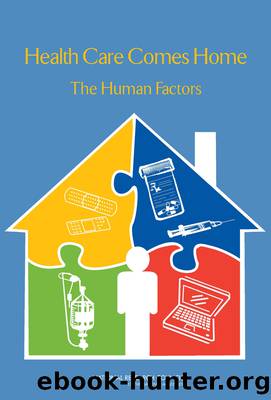Health care comes home: The human factors by Committee on the Role of Human Factors in Home Health Care

Author:Committee on the Role of Human Factors in Home Health Care
Language: eng
Format: epub
Publisher: The National Academies Press
Published: 2014-06-11T00:00:00+00:00
For persons who are not health care providers but whose experience or education has prepared them to some extent to perform the task, greater visual detail or more complex language may be used for training. Among formal caregivers new to health care in the home, training may need to emphasize insightful appraisal of their own capabilities and those of others (e.g., persons whom they supervise, such as people who receive care, family members, and coworkers on their team) and promote strategies for enhancing task performance. For formal caregivers with extensive experience providing health care in the home, training in the form of continuing education can incorporate methods for promoting these same assessment and tailored intervention skills. Health professional education and training programs for direct-care workers in health care in the home can likewise benefit from curricula infused with information gained from task analysis.
An example of the use of task analysis to support the efficient and effective selection of devices for home health care can be developed from Table 4-2, showing the subtasks involved in using a lancing device to obtain blood for monitoring glucose levels. A task analysis for use of the lancing device could be developed and included in a device database, like the one recommended in Chapter 7. Then, if assessment instruments were readily available to evaluate the capabilities of care recipients, as also recommended in Chapter 7, such an evaluation could be done on each recipient before a care plan is developed.
Then, whenever a provider was considering recommending (for example) that lancing device for a care recipient, the task demands of the device and of alternative devices performing the same function could be retrieved from the database and compared with the care recipientâs capabilities. This would allow the provider to determine whether that device or some other would be the best fit and whether the care recipient would need training, support, or assistance in using the device that is finally chosen. A skilled person, perhaps an appropriately trained occupational therapist, would be needed to evaluate the information on task demands and recipient capabilities, but a new task analysis would not be needed for each device/user analysis.
As an experience base developed, device designers could obtain feedback on the mismatches commonly found between the devices they have marketed and the actual capabilities of those who need to use the devices, informing the design of future devices to ensure their usability by the population in need of them.
In summary, human factors approaches applied to the ever-increasing array of health-related tasks performed in the home can be used to improve the systems, processes, and training available for their successful completion. This is not to say that a task analysis is done for each and every care recipient and caregiver. We recognize that would be prohibitively expensive and probably unnecessary. Ideally, task analyses are developed for specific tasks (e.g., glucose monitoring) and would specify the subtasks and capabilities needed to perform the task. Developers could use these analyses, in conjunction with other
Download
This site does not store any files on its server. We only index and link to content provided by other sites. Please contact the content providers to delete copyright contents if any and email us, we'll remove relevant links or contents immediately.
Cecilia; Or, Memoirs of an Heiress — Volume 1 by Fanny Burney(31351)
Cecilia; Or, Memoirs of an Heiress — Volume 3 by Fanny Burney(30949)
Cecilia; Or, Memoirs of an Heiress — Volume 2 by Fanny Burney(30907)
The Great Music City by Andrea Baker(21572)
We're Going to Need More Wine by Gabrielle Union(18086)
Bombshells: Glamour Girls of a Lifetime by Sullivan Steve(13119)
Pimp by Iceberg Slim(12947)
All the Missing Girls by Megan Miranda(12775)
Fifty Shades Freed by E L James(12463)
Talking to Strangers by Malcolm Gladwell(11908)
Norse Mythology by Gaiman Neil(11901)
Crazy Rich Asians by Kevin Kwan(8372)
Mindhunter: Inside the FBI's Elite Serial Crime Unit by John E. Douglas & Mark Olshaker(7850)
The Lost Art of Listening by Michael P. Nichols(6484)
Enlightenment Now: The Case for Reason, Science, Humanism, and Progress by Steven Pinker(6414)
Bad Blood by John Carreyrou(5782)
The Four Agreements by Don Miguel Ruiz(5533)
Weapons of Math Destruction by Cathy O'Neil(5046)
We Need to Talk by Celeste Headlee(4881)
